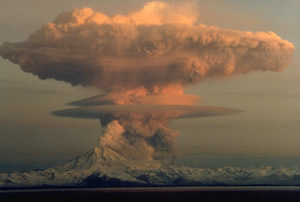Alaska Volcano Observatory celebrates 20 years of service, science
Alaska Volcano Observatory celebrates 20 years of service, science
Submitted by Amy Hartley
Phone: 907-474-5823
04/25/08

For the last 20 years, Alaska has been a safer place, despite being home to more than 50 historically active volcanoes. This security comes from the service and research conducted by a team of scientists with the Alaska Volcano Observatory, a joint project between the Geophysical Institute at the University of Alaska Fairbanks, the U.S. Geological Survey, and the Alaska Division of Geological and Geophysical Surveys.
In honor of AVO’s 20th anniversary, a reception is scheduled for April 29, 2008 in Anchorage, Alaska. The event will bring together affiliated scientists, partners, legislators, community members and more to celebrate the key role the observatory has played in terms of public safety and the advancement of science. The reception will take place at 4 p.m. at the Anchorage Marriott Downtown, located on 7th Avenue.
The Alaska Volcano Observatory was founded in 1988, just 18 months prior to the eruption of Mount Redoubt in Southcentral Alaska. At that time, the newly established observatory was able to alert government authorities and the public of the impending eruption at Redoubt, and emergency preparations were made that may have saved countless lives and property in the area.
Every day more than 250 flights and about 30,000 people fly near potentially active volcanoes in Alaska and Russia. Airborne volcanic ash is one of the greatest threats of volcanic eruptions in Alaska and neighboring Kamchatka. Since its establishment, AVO has worked closely with the Federal Aviation Administration and the National Weather Service to divert air traffic away from volcanic clouds and active volcanoes.
Nearly a dozen scientists from the Geophysical Institute are affiliated with AVO, providing expertise in remote sensing, seismology and volcanology. The GI team also is on the forefront of training future volcanologists, and currently has 11 graduate students working on AVO-related projects.
CONTACT: Steve McNutt, research professor of seismology, GI/AVO, at 907-474-7131 or steve@giseis.alaska.edu. Ken Dean, professor of remote sensing, GI/AVO at 907-474-7364 or ken.dean@gi.alaska.edu. Jon Dehn, associate professor of remote sensing, GI/AVO at 907-474-6499 or jdehn@gi.alaska.edu.
ON THE WEB:
www.avo.alaska.edu
www.gi.alaska.edu


